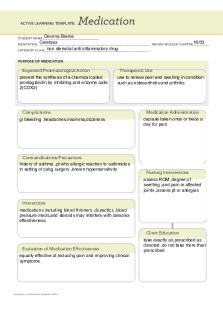Divalproex - Medication Template for NCLEX based medication PDF

| Title | Divalproex - Medication Template for NCLEX based medication |
|---|---|
| Author | ryann starcher |
| Course | Medical Surgical Clinical |
| Institution | San Joaquin Valley College |
| Pages | 1 |
| File Size | 56.9 KB |
| File Type | |
| Total Downloads | 76 |
| Total Views | 127 |
Summary
Medication Template for NCLEX based medication...
Description
ACTIVE LEARNING TEMPLATE:
Medication
Ryann Starcher STUDENT NAME _____________________________________
divalproex soduim, Depakote, Depakote ER, Depakote Sprinkle MEDICATION __________________________________________________________________________ REVIEW MODULE CHAPTER ___________ Anticonvulsant, vascular headache suppressant CATEGORY CLASS ______________________________________________________________________ PURPOSE OF MEDICATION
Expected Pharmacological Action Decreases seizure activity by increasing levels of GABA.
Therapeutic Use Decreases seizures, manic episodes in bipolar disorder, prophylaxis of migraine.
Complications Sedation, drowsiness, dizziness, headache, depression, behavioral changes, tremors, aggression, weakness, coma, suicidal ideation, hypothermia, peripheral edema, visual disturbances, taste perversion, nausea, vomiting, constipation, diarrhea, dyspepsia, anorexia, pancreatitis, stomatitis, weight gain, dry mouth, hepatotoxicity, thrombocytopenia, leukopenia, rash, alopecia, photosensitivity, dry skin, DRESS, hyperammonemia, SIADH
Medication Administration Simple/complex absence seizures or complex partial seizures: Adults IV/PO10-15 mg/kg/day increase weekly by 5-19 mg/kg/day max of 60 mg/kg/day. Rectal enema 17-20 mg/kg, then 10-15 mg/kg/dose every 8 hr dilute 1:1 water Acute Mania: Adults PO delayed release: 750 mg/day divided doses, increase to lowest effective dose rapidly up to 60 mg/kg/day. ER-25 mg/kg/day increase to desired clinical effect rapidly. Migraine prophylaxis: Adutls PO: DR- 250 mg bid up to 500 mg bid. ER-500 mg daily for 1 week titrate up to 1000 mg daily.
Contraindications/Precautions Hypersensitivity, urea cycle disorders, mitochondrial disease, hepatic disease, breastfeeding, geriatric patients, abrupt discontinuation, carnitine deficiency, coagulopathy, depression, diarrhea, encephalopathy, head trauma, organic brain syndrome, HIV, renal disease, suicidal ideation, surgery, and thrombocytopenia.
Interactions Increases CNS depression with alcohol, opioids, barbiturates, antihistamines, MAOIs, sedative/hypnotics. Increase possible toxicity with phenytoin, carbamazepine, ethosuximide, barbiturates, zidovudine, lorazepam, rufinamide, and lamotrigine. Increased bleeding with warfarin. Decreased seizure threshold with TCA's.
Nursing Interventions Assess mental status and suicidal thoughts and behaviors. Assess for hyperammonemic encphalopahy with patients with urea cycle disorders (lethargy, confusion, coma, CV, respiratory changes). Assess location, aura, activity and duration of seizures. Assess frequency, intensity, and alleviating factors of migraines. LABS: Hct, Hgb, RBC, serum folate, PT/PTT,serum ammonia, platelets, Vit D (long term therapy)
Client Education Evaluation of Medication Effectiveness Decrease in seizures and migraines.
ACTIVE LEARNING TEMPLATES
Take as directed and do not discontinue quickly. Avoid driving as it may cause drowsiness. Drink plenty of fluids. Contact PCP if visual disturbances, rash, diarrhea, abdominal pain, light-colored stools, jaundice, protracted vomiting, weakness, fever, swelling of lymph glads, anorexia, nausea, or vomiting immediately. Follow-up exams and blood work will be needed....
Similar Free PDFs

ATI. Nclex Medication List
- 18 Pages

ATI Warfarin Medication Template
- 1 Pages
Popular Institutions
- Tinajero National High School - Annex
- Politeknik Caltex Riau
- Yokohama City University
- SGT University
- University of Al-Qadisiyah
- Divine Word College of Vigan
- Techniek College Rotterdam
- Universidade de Santiago
- Universiti Teknologi MARA Cawangan Johor Kampus Pasir Gudang
- Poltekkes Kemenkes Yogyakarta
- Baguio City National High School
- Colegio san marcos
- preparatoria uno
- Centro de Bachillerato Tecnológico Industrial y de Servicios No. 107
- Dalian Maritime University
- Quang Trung Secondary School
- Colegio Tecnológico en Informática
- Corporación Regional de Educación Superior
- Grupo CEDVA
- Dar Al Uloom University
- Centro de Estudios Preuniversitarios de la Universidad Nacional de Ingeniería
- 上智大学
- Aakash International School, Nuna Majara
- San Felipe Neri Catholic School
- Kang Chiao International School - New Taipei City
- Misamis Occidental National High School
- Institución Educativa Escuela Normal Juan Ladrilleros
- Kolehiyo ng Pantukan
- Batanes State College
- Instituto Continental
- Sekolah Menengah Kejuruan Kesehatan Kaltara (Tarakan)
- Colegio de La Inmaculada Concepcion - Cebu













